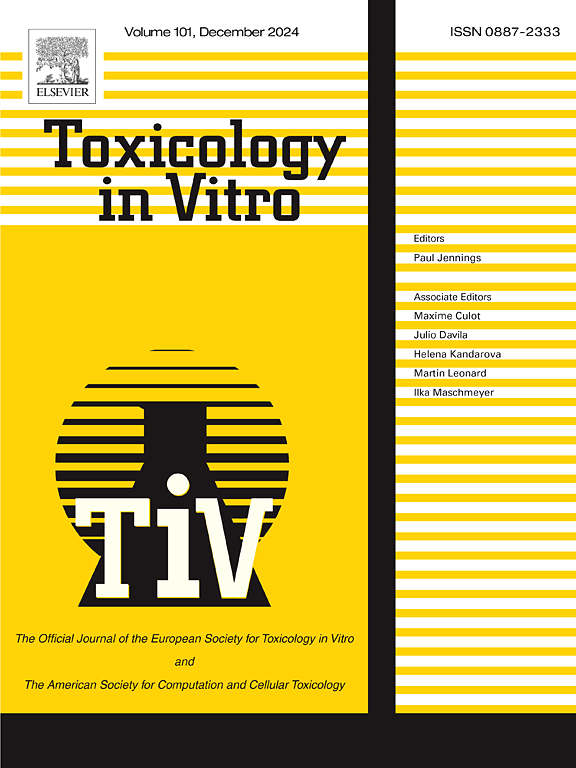人甲状腺过氧化物酶抑制剂的高通量筛选试验。
IF 2.6
3区 医学
Q3 TOXICOLOGY
引用次数: 0
摘要
我们需要快速、与人体相关的检测方法来评估许多商业化学品的潜在危害。最近,一种使用底物 Amplex Ultra Red 的甲状腺过氧化物酶(TPO)抑制测定法(AUR-hTPO)适用于人类 TPO。我们通过这种 AUR-hTPO 检测法测试了大量(788 种)化学品,并将其性能与使用大鼠甲状腺微粒体酶(AUR-rTPO)进行检测的结果进行了比较。对美国环保局毒物目录(US EPA ToxCast Inventory)中的编码化学品进行了分层测试:1)单浓度初筛;2)多浓度活性化学品的效力评估;3)活性化学品的非特异性活性筛查。对于阳性化学品甲巯咪唑和几种阳性及阴性参考化学品,检测结果一致。其中 158 种未显示出混杂活性(荧光干扰或非特异性蛋白质抑制)。将所有结果与 rTPO 数据以及文献中发现的 TPO 抑制证据进行比较后发现,与 rTPO 筛查相比,目前的检测方法假阴性率较高,但假阳性率要低得多。这些发现强调了 AUR 检测法使用工程细胞系的 hTPO 酶鉴定中强抑制剂的有效性,但在检测弱 TPO 抑制剂方面可能还需要一些改进。本文章由计算机程序翻译,如有差异,请以英文原文为准。

A high throughput screening assay for human Thyroperoxidase inhibitors
Rapid, human relevant assays are needed to assess potential hazards of the many chemicals in commerce. An assay of thyroid peroxidase (TPO) inhibition, using the substrate Amplex Ultra Red, was recently adapted for human TPO (AUR-hTPO). We tested a large number (788) of chemicals through this AUR-hTPO assay and compared performance with published results from an assay using enzyme from rat thyroid microsomes (AUR-rTPO). Coded chemicals, from the US EPA ToxCast Inventory, were tested in a tiered approach: 1) Initial screening at a single concentration; 2) Potency estimation for active chemicals with multiple concentrations; 3) Screening active chemicals for the non-specific activity. The assay gave consistent results for positive chemical methimazole and several positive and negative reference chemicals. hTPO inhibition was observed for 190 chemicals reported as positive in rTPO. Of these, 158 showed no confounding activity (interference due to fluorescence or non-specific protein inhibition). Comparison of all result with rTPO data and with evidence of TPO inhibition found in the literature suggest that the current assay has a higher rate of false negative but a much lower rate of false positive compared with the rTPO screen. These findings underscore the effectiveness of the AUR assay, using hTPO enzyme from engineered cell lines, to identify moderate to strong inhibitors but some improvements may be needed to detect weak TPO inhibitors.
求助全文
通过发布文献求助,成功后即可免费获取论文全文。
去求助
来源期刊

Toxicology in Vitro
医学-毒理学
CiteScore
6.50
自引率
3.10%
发文量
181
审稿时长
65 days
期刊介绍:
Toxicology in Vitro publishes original research papers and reviews on the application and use of in vitro systems for assessing or predicting the toxic effects of chemicals and elucidating their mechanisms of action. These in vitro techniques include utilizing cell or tissue cultures, isolated cells, tissue slices, subcellular fractions, transgenic cell cultures, and cells from transgenic organisms, as well as in silico modelling. The Journal will focus on investigations that involve the development and validation of new in vitro methods, e.g. for prediction of toxic effects based on traditional and in silico modelling; on the use of methods in high-throughput toxicology and pharmacology; elucidation of mechanisms of toxic action; the application of genomics, transcriptomics and proteomics in toxicology, as well as on comparative studies that characterise the relationship between in vitro and in vivo findings. The Journal strongly encourages the submission of manuscripts that focus on the development of in vitro methods, their practical applications and regulatory use (e.g. in the areas of food components cosmetics, pharmaceuticals, pesticides, and industrial chemicals). Toxicology in Vitro discourages papers that record reporting on toxicological effects from materials, such as plant extracts or herbal medicines, that have not been chemically characterized.
 求助内容:
求助内容: 应助结果提醒方式:
应助结果提醒方式:


